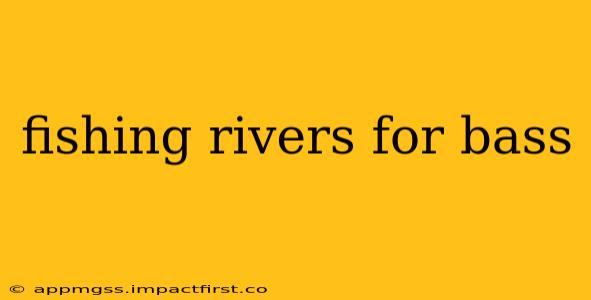Bass fishing in rivers presents a unique challenge and reward compared to lake fishing. The current, varying depths, and structure create a dynamic environment demanding adaptability and specific techniques. This guide will delve into the best strategies for targeting river bass, covering everything from choosing the right location to mastering the perfect cast.
What are the best lures for river bass?
The best lures for river bass depend heavily on the river's characteristics and the time of year. However, some consistently productive choices include:
-
Spinnerbaits: These are excellent for covering water quickly and enticing bass in faster currents. The blades' flash and vibration attract fish from a distance. Choose spinnerbaits with willow leaf blades for slower currents and Colorado blades for faster currents.
-
Crankbaits: These work well for targeting bass holding near structure like rocks, logs, and riverbeds. Choose crankbaits that run at various depths depending on the river's structure. A shallow-diving crankbait excels in shallower areas, while a deep-diving crankbait is suitable for deeper pools.
-
Jerkbaits: These versatile lures are effective for provoking strikes from aggressive bass. The erratic action imitates injured baitfish, triggering a reactive strike.
-
Texas-rigged worms/soft plastics: These are excellent for targeting bass in slower currents or around cover. The weight helps maintain contact with the bottom, allowing you to feel structure and subtle bites.
-
Topwater lures: These are highly effective during low-light conditions or when bass are actively feeding on the surface. Poppers and buzzbaits are particularly effective for creating surface disturbance that attracts aggressive strikes.
What is the best time of year to fish for bass in a river?
The best time of year to fish for bass in a river is generally during the spring and fall. In spring, bass are actively spawning and feeding aggressively to replenish energy after winter. Fall offers a similar feeding frenzy as bass prepare for winter. Summer can also be productive, but targeting deeper pools and shaded areas becomes crucial due to warmer water temperatures. Winter fishing can be challenging, but slow-retrieving lures in deeper holes can still produce results.
What are the best locations to fish for bass in a river?
River bass tend to congregate in areas with specific features that offer cover, food, and ambush points. Prime locations include:
-
River bends: The current slows down in bends, creating calmer areas where bass can easily ambush prey.
-
Drop-offs: The transition between shallow and deep water creates ambush points where bass can wait for unsuspecting baitfish.
-
Structure: Rocks, logs, overhanging branches, and submerged vegetation provide excellent cover for bass.
-
Deep pools: These areas offer refuge from strong currents and provide a concentration of baitfish.
-
Eddies: These swirling currents create calm pockets where baitfish gather, making them prime feeding areas for bass.
What techniques should I use when fishing for river bass?
Successful river bass fishing requires mastering specific techniques:
-
Upstream Casting: Casting upstream allows your lure to drift naturally with the current, mimicking the movement of baitfish.
-
Downstream Casting: Casting downstream allows you to cover more water quickly, especially when targeting fast-moving areas.
-
Adjusting your retrieve: The speed and style of your retrieve need to be adjusted according to the current and the type of lure you are using. A slower retrieve is often more effective in slower currents.
-
Maintaining contact with the bottom: This allows you to feel the structure and detect subtle bites, which is especially important when using soft plastics or jigs.
What are some common mistakes to avoid when river bass fishing?
Avoid these common mistakes to improve your chances of success:
-
Using inappropriate tackle: Strong line is crucial to combat the current and strong river bass.
-
Neglecting current conditions: Pay close attention to the current’s speed and direction, and adjust your casting and retrieving techniques accordingly.
-
Ignoring structure: Focus your efforts on areas with ample cover and structure.
-
Overfishing a spot: If you're not getting bites, move to a new location.
How do I choose the right fishing rod and reel for river bass?
Choosing the right gear is essential for effective river bass fishing. Medium-heavy power rods with moderate-fast action are ideal for handling the current and setting the hook firmly. A reel with a good drag system is also essential to handle strong runs. Consider a baitcasting reel for greater casting accuracy and control, or a spinning reel for easier casting and retrieving.
By understanding the nuances of river bass behavior, utilizing the appropriate techniques and lures, and choosing the right equipment, you significantly increase your chances of landing a trophy river bass. Remember to always practice responsible fishing and adhere to local regulations.
